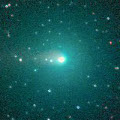
|
It brightened up to 7.0 mag until early June (June 9, Michael Mattiazzo). It had been brightening very rapidly, but the brightness evolution slow down recently. Michael Mattiazzo reported it was 7.5 mag on June 21 in SOHO images. It will approach to the sun down to 0.66 a.u. in July, and brighten up to 6 mag. Now it is not observable. After the perihelion passage, it will be observable in excellent condition after late July in the Northern Hemisphere. In the Southern Hemisphere, it keeps unobservable until early September.
Date(TT) R.A. (2000) Decl. Delta r Elong. m1 Best Time(A, h)
July 5 5 51.51 21 49.7 1.597 0.666 14 6.0 3:05 (235, -9)
July 12 5 40.64 24 48.4 1.488 0.693 23 6.0 3:11 (240, 1)
|
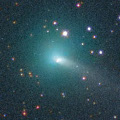
|
Cometary activity began in April. Now it is bright as 9.7 mag (July 3, Marek Biely). It will brighten up to 7 mag in July, and will be observable in excellent condition in the Northern Hemisphere. In the Southern Hemisphere, it is not observable temporarily in mid July, but it is observable before and after mid July.
Date(TT) R.A. (2000) Decl. Delta r Elong. m1 Best Time(A, h)
July 5 23 37.94 39 27.4 0.379 1.081 89 8.0 3:05 (253, 69)
July 12 19 15.28 64 10.2 0.319 1.085 93 7.6 23:17 (180, 61)
|

|
Now it is bright as 7.9 mag (July 3, Marek Biely). The brightening is somewhat slow, but it is expected to brighten up to 6-7 mag in autumn. It is not observable from mid July to mid September.
Date(TT) R.A. (2000) Decl. Delta r Elong. m1 Best Time(A, h)
July 5 9 42.88 28 1.5 2.021 1.371 38 8.2 21:03 (115, 13)
July 12 9 36.65 25 28.0 2.073 1.304 30 8.1 20:59 (117, 6)
|
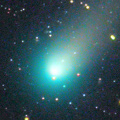
|
It brightened rapidly in outburst in mid October in 2013. Now it is bright as 9.2 mag (July 3, Chris Wyatt). It will be fading gradually after this. In the Southern Hemisphere, it keeps observable in good condition for a long time until the comet fades out. In the Northern Hemisphere, it keeps extremely low after this.
Date(TT) R.A. (2000) Decl. Delta r Elong. m1 Best Time(A, h)
July 5 22 33.22 -33 41.4 1.559 2.358 131 9.3 3:05 (352, 21)
July 12 22 32.17 -36 45.4 1.576 2.421 136 9.4 3:11 (359, 18)
|
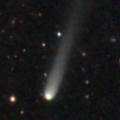
|
Now it is 11.6 mag (July 3, Chris Wyatt). The brightening is somewhat slow, but it is expected to brighten up to 8.5 mag and to be observable in excellent condition from summer to autumn in the Southern Hemisphere. It keeps observable for a long time until early November in the Southern Hemisphere. In the Northern Hemisphere, it appears in the extremely low sky from late July to early August. But then it keeps unobservable until October. It will pass extremely close to Mars on Oct. 19.
Date(TT) R.A. (2000) Decl. Delta r Elong. m1 Best Time(A, h)
July 5 3 20.79 -27 43.0 2.172 2.100 72 11.4 3:05 (298, -9)
July 12 3 22.65 -29 42.7 1.990 2.033 77 11.1 3:11 (303, -5)
|
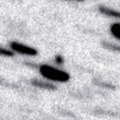
|
The condition in this apparition is bad. It locates low around the brightest days. Now it is not observable. It will appear in the morning sky at 13 mag in late July.
Date(TT) R.A. (2000) Decl. Delta r Elong. m1 Best Time(A, h)
July 5 5 13.08 18 43.2 2.570 1.695 24 12.4 3:05 (244, -4)
July 12 5 33.23 18 42.2 2.564 1.711 26 12.4 3:11 (246, -2)
|
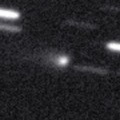
|
Now it is 14.9 mag (Apr. 18, Taras Prystavski). It is expected to brighten up to 5 mag in 2014 autumn. Now it is not observable. It will be observable again in July in the Southern Hemisphere, or in August in the Northern Hemisphere.
Date(TT) R.A. (2000) Decl. Delta r Elong. m1 Best Time(A, h)
July 5 5 33.78 15 38.8 2.635 1.720 20 13.0 3:05 (243,-10)
July 12 5 39.68 15 1.0 2.471 1.615 25 12.5 3:11 (248, -5)
|
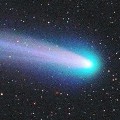
|
It passed only 0.4 A.U. from the earth, and 0.8 A.U. from the sun in November and December in 2013, and brightened up to 4.7 mag (Nov. 28, Juan Jose Gonzalez). Now it is 11.8 mag (May 31, Carlos Labordena). It keeps observable until autumn when the comet fades out.
Date(TT) R.A. (2000) Decl. Delta r Elong. m1 Best Time(A, h)
July 5 15 45.55 -26 42.7 2.256 3.078 136 12.9 21:03 ( 3, 28)
July 12 15 40.26 -27 14.4 2.418 3.161 129 13.2 20:59 ( 10, 27)
|

|
Now it is 18.1 mag (June 18, Hidetaka Sato). Much fainter than predicted. It will brighten very rapidly after this, and it is expected to reach up to 10 mag in August. It keeps observable in the morning sky until mid August while the comet will be brightening. The condition is good in the Southern Hemisphere. But it keeps extremely low in the Northern Hemisphere.
Date(TT) R.A. (2000) Decl. Delta r Elong. m1 Best Time(A, h)
July 5 3 6.63 8 5.5 1.087 1.001 56 14.2 3:05 (271, 15)
July 12 3 52.42 11 21.4 1.051 0.899 51 13.4 3:11 (266, 14)
|
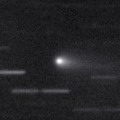
|
Now it is 14.2 mag (May 27, Taras Prystavski). It keeps bright as 13-14 mag for a long time from 2013 to 2014.
Date(TT) R.A. (2000) Decl. Delta r Elong. m1 Best Time(A, h)
July 5 21 6.21 -28 11.0 2.173 3.096 150 13.5 2:16 ( 0, 27)
July 12 21 2.77 -28 45.1 2.141 3.101 156 13.5 1:45 ( 0, 26)
|

|
New outburst occured on May 2, and it brightened up to 13.0 mag (May 3, Seiichi Yoshida). Another outburst occured on May 12, and it brightened up to 12.7 mag (May 12, Con Stoitsis). It was bright as 12.4 mag still in late May (May 27, Marco Goiato). No bright observations were reported in June.
Date(TT) R.A. (2000) Decl. Delta r Elong. m1 Best Time(A, h)
July 5 15 20.24 -28 45.4 5.407 6.129 131 13.6 21:03 ( 9, 26)
July 12 15 19.22 -28 30.3 5.489 6.128 124 13.6 20:59 ( 15, 25)
|

|
Now it is 13.4 mag (July 1, Sandor Szabo). It keeps bright at 13-14 mag for a long time until 2014.
Date(TT) R.A. (2000) Decl. Delta r Elong. m1 Best Time(A, h)
July 5 19 9.98 0 43.4 5.624 6.567 156 14.0 0:20 ( 0, 56)
July 12 19 3.88 0 1.7 5.639 6.589 157 14.0 23:42 ( 0, 55)
|
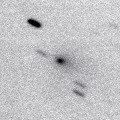
|
It brightened up to 2 mag by unusual major outburst in 2007. It is coming back now. Now it is bright as 13.1 mag (June 7, Alan Hale). In the Northern Hemisphere, it keeps observable until it fades out in 2015. In the Southern Hemisphere, it keeps extremely low after this.
Date(TT) R.A. (2000) Decl. Delta r Elong. m1 Best Time(A, h)
July 5 2 54.85 31 16.0 2.643 2.197 53 14.1 3:05 (250, 29)
July 12 3 8.70 32 50.2 2.603 2.216 56 14.2 3:11 (251, 33)
|
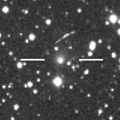
|
Brightened rapidly. Now it is 14.5 mag (May 21, Taras Prystavski). It will brighten up to 13-14 mag and will be observable in excellent condition from spring to summer in the Southern Hemisphere. It locates low in the Northern Hemispehre.
Date(TT) R.A. (2000) Decl. Delta r Elong. m1 Best Time(A, h)
July 5 11 13.38 -14 47.5 1.963 1.937 73 14.2 21:03 ( 66, 7)
July 12 11 32.42 -14 51.2 2.025 1.951 71 14.3 20:59 ( 67, 6)
|
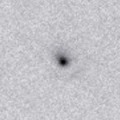
|
In the Northern Hemisphere, it will appear in the morning sky in late July. Then it will be observable at 12-13 mag in excellent condition from 2014 summer to 2015 spring. In the Southern Hemisphere, it will locate low around the highlight.
Date(TT) R.A. (2000) Decl. Delta r Elong. m1 Best Time(A, h)
July 5 5 12.36 24 19.3 3.102 2.209 23 14.5 3:05 (240, 0)
July 12 5 29.10 24 53.8 3.046 2.184 26 14.4 3:11 (241, 3)
|
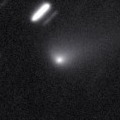
|
It brightened up to 12-13 mag from April to May. Now it is fading. But it is still visible visually at 14.0 mag (July 1, Sandor Szabo).
Date(TT) R.A. (2000) Decl. Delta r Elong. m1 Best Time(A, h)
July 5 14 4.37 -9 33.7 2.074 2.597 109 14.4 21:03 ( 36, 38)
July 12 14 10.16 -10 1.2 2.160 2.606 104 14.5 20:59 ( 40, 36)
|

|
It brightened up to 11-12 mag in 2012. Now it is 14.2 mag (May 21, Taras Prystavski). It will be unobservable in July in the Northern Hemisphere, or in August in the Southern Hemisphere. But it will be observable at 15 mag in good condition again in 2015.
Date(TT) R.A. (2000) Decl. Delta r Elong. m1 Best Time(A, h)
July 5 11 48.61 -6 34.1 7.974 7.815 77 14.5 21:03 ( 67, 18)
July 12 11 48.38 -6 30.5 8.128 7.851 70 14.6 20:59 ( 71, 14)
|
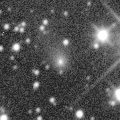
|
Now it is bright as 13.6 mag (June 4, Taras Prystavski). It keeps 13-14 mag and observable in good condition in the Northern Hemisphere for a long time from 2013 to 2014. In the Southern Hemisphere, it is not observable until 2014 autumn.
Date(TT) R.A. (2000) Decl. Delta r Elong. m1 Best Time(A, h)
July 5 1 17.69 53 7.9 4.119 3.867 68 14.7 3:05 (227, 50)
July 12 1 13.98 53 21.1 4.053 3.896 73 14.7 3:11 (224, 56)
|
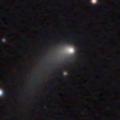
|
Now it is 14.2 mag (May 22, Taras Prystavski). It keeps 14 mag for a long time until 2014 summer. It keeps observable in good condition in the Northern Hemisphere. It keeps unobservable after this in the Southern Hemisphere.
Date(TT) R.A. (2000) Decl. Delta r Elong. m1 Best Time(A, h)
July 5 10 39.03 62 28.8 2.338 1.931 54 14.7 21:03 (146, 36)
July 12 11 15.26 59 40.8 2.377 1.978 55 14.8 20:59 (142, 37)
|
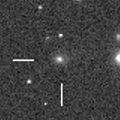
|
Now it is 14.8 mag (May 22, Taras Prystavski). It is expected to brighten up to 13 mag and to be observable in good condition in 2015. In 2014, it keeps observable in good condition from winter to summer.
Date(TT) R.A. (2000) Decl. Delta r Elong. m1 Best Time(A, h)
July 5 13 38.17 0 8.1 3.975 4.268 99 14.8 21:03 ( 50, 43)
July 12 13 40.60 -0 13.2 4.039 4.232 93 14.8 20:59 ( 55, 39)
|

|
New bright comet. Now it is 13.6 mag (June 25, Hidetaka Sato), brighter than this ephemeris. It is observable at 14 mag in excellent condition until November.
Date(TT) R.A. (2000) Decl. Delta r Elong. m1 Best Time(A, h)
July 5 23 36.62 -2 23.3 1.571 2.131 109 15.1 3:05 (322, 46)
July 12 23 43.56 -2 0.3 1.500 2.126 113 15.0 3:11 (331, 49)
|

|
Big asteroid discovered in 1906. It suddenly showed the cometary activity on Dec. 11, 2010, probably due to an impact of a small object. It has already turned to be stellar.
Date(TT) R.A. (2000) Decl. Delta r Elong. m1 Best Time(A, h)
July 5 3 52.89 15 9.8 4.032 3.370 43 15.3 3:05 (258, 9)
July 12 4 0.86 15 40.7 3.965 3.374 48 15.3 3:11 (261, 15)
|

|
Now it is 16.4 mag (June 9, A. Maury, J.-G. Bosch, J.-F. Soulier, T. Noel). In the Northern Hemisphere, it will be getting higher gradually after this, and keeps observable in good condition while the comet will be fading gradually. In the Southern Hemisphere, it keeps extremely low.
Date(TT) R.A. (2000) Decl. Delta r Elong. m1 Best Time(A, h)
July 5 4 4.76 17 22.6 2.184 1.554 40 15.4 3:05 (255, 8)
July 12 4 25.25 19 19.1 2.151 1.548 41 15.4 3:11 (255, 12)
|
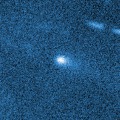
|
Now it is 15.8 mag (May 6, A. Maury, J.-G. Bosch, J.-F. Soulier, T. Noel). It keeps 15-16 mag until August. But it keeps low for a while.
Date(TT) R.A. (2000) Decl. Delta r Elong. m1 Best Time(A, h)
July 5 4 7.16 18 19.2 2.133 1.495 39 15.4 3:05 (253, 8)
July 12 4 28.84 19 3.2 2.124 1.511 40 15.5 3:11 (254, 11)
|
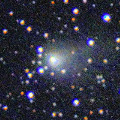
|
First return of a new periodic comet discovered in 1998. It brightened up to 10 mag at the discovery, but it brightened up to 11-12 mag at best in this apparition. Now it is 13.8 mag (May 21, Taras Prystavski). It will be fading after this. It is already unobservable in the Northern Hemisphre. It keeps observable until August in the Southern Hemisphere.
Date(TT) R.A. (2000) Decl. Delta r Elong. m1 Best Time(A, h)
July 5 9 43.91 2 43.0 3.005 2.405 45 15.5 21:03 ( 94, -1)
July 12 9 56.32 1 18.3 3.085 2.433 42 15.7 20:59 ( 94, -4)
|

|
Fianlly observed after a 36-year blank since 1978. Now it is 16.3 mag (June 20, Hidetaka Sato). Hidetaka Sato reported it was fainter than 21 mag on May 7. It keeps 15-16 mag until July. However, it locates extremely low in the morning sky. It will fade out very rapidly after that, and will be fainter than 18 mag in August.
Date(TT) R.A. (2000) Decl. Delta r Elong. m1 Best Time(A, h)
July 5 3 58.04 16 51.6 1.164 0.793 41 15.5 3:05 (256, 9)
July 12 4 35.38 19 52.1 1.234 0.784 39 15.5 3:11 (253, 10)
|
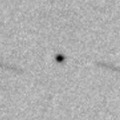
|
Now it is 15.9 mag (June 2, Taras Prystavski). Getting brighter than originally expected. It is expected to brighten up to 4 mag from autumn to winter in 2015. It already locates high in the Southern Hemisphere. It will be getting higher gradually also in the Northern Hemisphere. It is observable in good condition in the Southern Hemisphere until the highlight, or in the Northern Hemisphere after the highlight.
Date(TT) R.A. (2000) Decl. Delta r Elong. m1 Best Time(A, h)
July 5 0 2.81 -13 18.0 5.830 6.204 107 15.7 3:05 (322, 33)
July 12 0 1.42 -13 51.9 5.656 6.140 114 15.6 3:11 (332, 37)
|

|
Now it is 17.9 mag (June 2, Hidetaka Sato). It will brighten up to 15.5 mag in July. But it locates extremely low in the morning sky. It will fade out very rapidly after that, and will be fainter than 18 mag in August.
Date(TT) R.A. (2000) Decl. Delta r Elong. m1 Best Time(A, h)
July 5 3 45.49 18 55.5 1.060 0.784 44 15.7 3:05 (256, 13)
July 12 4 19.33 21 22.5 1.140 0.794 42 15.7 3:11 (254, 14)
|
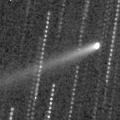
|
It approached to the earth down to 0.06 a.u. in late May, and looked very bright as 11.8 mag (May 29, Marco Goiato). It will be fading very rapidly after this. In the Southern Hemisphere, it keeps observable for a long time until the comet fades out. It will never be observable again in the Northern Hemisphere.
Date(TT) R.A. (2000) Decl. Delta r Elong. m1 Best Time(A, h)
July 5 16 53.58 -73 40.8 0.368 1.271 126 16.0 22:04 ( 0,-19)
July 12 17 22.14 -71 58.9 0.440 1.330 127 16.5 22:04 ( 0,-17)
|
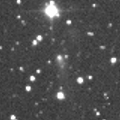
|
Now it is 14.9 mag (May 21, Taras Prystavski), brighter than origianlly predicted. It will be observable at 14-16 mag for a long time from 2013 to 2014.
Date(TT) R.A. (2000) Decl. Delta r Elong. m1 Best Time(A, h)
July 5 15 41.97 -24 48.4 3.485 4.274 135 16.1 21:03 ( 4, 30)
July 12 15 41.02 -24 45.8 3.576 4.291 129 16.1 20:59 ( 10, 29)
|
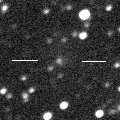
|
Now it is 16.5 mag (May 21, Taras Prystavski). Distant object, but it keeps observable at 14 mag for a long time from 2015 to 2016.
Date(TT) R.A. (2000) Decl. Delta r Elong. m1 Best Time(A, h)
July 5 19 8.62 -1 58.4 5.914 6.872 158 16.2 0:19 ( 0, 53)
July 12 19 6.11 -2 5.5 5.878 6.840 159 16.2 23:44 ( 0, 53)
|
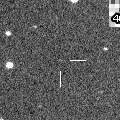
|
Now it is 17.2 mag (June 7, Hidetaka Sato). First return of a new periodic comet which brightened up to 13 mag in 2007. It was expected to brighten up to 13 mag again and observable in good condition from summer to autumn in 2014. But actually, it is fainter than expected. It will be 16 mag at best actually.
Date(TT) R.A. (2000) Decl. Delta r Elong. m1 Best Time(A, h)
July 5 23 30.15 -4 10.5 1.756 2.326 111 16.7 3:05 (326, 45)
July 12 23 35.89 -4 18.1 1.677 2.318 116 16.6 3:11 (335, 48)
|
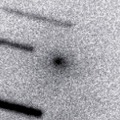
|
It approached to the sun down to 0.8 a.u. on May 29, and brightened up to 13.1 mag (June 4, Taras Prystavski). Now it is fading very rapidly. It will be fainter than 18 mag soon.
Date(TT) R.A. (2000) Decl. Delta r Elong. m1 Best Time(A, h)
July 5 3 48.71 15 58.5 1.423 0.995 44 16.7 3:05 (258, 11)
July 12 4 11.44 17 6.6 1.480 1.055 45 17.4 3:11 (258, 13)
|
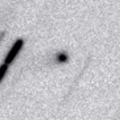
|
It is expected to brighten up to 14 mag from 2015 to 2016. It is observable in good condition in the Southern Hemisphere. It will be observable also in the Northern Hemisphere after mid August.
Date(TT) R.A. (2000) Decl. Delta r Elong. m1 Best Time(A, h)
July 5 5 26.71 -18 49.7 6.101 5.458 46 16.8 3:05 (274,-29)
July 12 5 28.91 -18 44.9 6.027 5.423 49 16.7 3:11 (278,-23)
|

|
Now it is 16.5 mag (Apr. 16, Taras Prystavski). It keeps 17 mag for a long time from 2014 to 2015. It is observable in excellent condition in the Northern Hemisphere. It is observable only until 2014 summer in the Southern Hemisphere.
Date(TT) R.A. (2000) Decl. Delta r Elong. m1 Best Time(A, h)
July 5 15 36.89 35 27.0 3.637 4.024 105 16.9 21:03 ( 97, 86)
July 12 15 35.50 35 24.6 3.685 4.007 101 16.9 20:59 ( 95, 81)
|
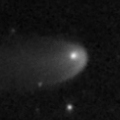
|
It brightened up to 13 mag from 2011 to 2012. It will be fading after this, but it keeps brighter than 18 mag until 2015 spring. Although it had been low for a while, now it locates high in the morning sky again in the Southern Hemisphere. It will be getting higher also in the Northern Hemisphere after late July.
Date(TT) R.A. (2000) Decl. Delta r Elong. m1 Best Time(A, h)
July 5 3 50.21 -4 52.6 9.012 8.440 52 16.9 3:05 (275, -2)
July 12 3 52.10 -4 43.2 8.964 8.474 58 16.9 3:11 (279, 5)
|
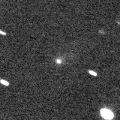
|
It brightened rapidly, and reached up to 15.7 mag (Apr. 22, Taras Prystavski). It will start fading after June, and will be fainter than 18 mag in August.
Date(TT) R.A. (2000) Decl. Delta r Elong. m1 Best Time(A, h)
July 5 13 57.24 -20 44.9 1.576 2.167 111 17.0 21:03 ( 31, 27)
July 12 14 3.29 -21 48.0 1.655 2.176 106 17.2 20:59 ( 35, 25)
|
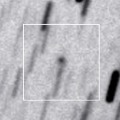
|
Now it is 17.5 mag (Apr. 5, N. James). It keeps observable at 18 mag for a long time from 2013 to 2016. It keeps locating high in the Northern Hemisphere. It keeps locating very low in the Southern Hemipshere.
Date(TT) R.A. (2000) Decl. Delta r Elong. m1 Best Time(A, h)
July 5 17 52.97 51 5.1 6.135 6.470 104 17.0 22:58 (180, 74)
July 12 17 43.39 51 10.0 6.154 6.468 103 17.1 22:21 (180, 74)
|

|
Now it is 17.3 mag (June 2, Hidetaka Sato). Slightly fainter than expected. Extremely low in the morning sky. It will fade out very rapidly after this, and will be fainter than 18 mag in July.
Date(TT) R.A. (2000) Decl. Delta r Elong. m1 Best Time(A, h)
July 5 4 22.56 21 29.3 1.844 1.172 35 17.1 3:05 (249, 7)
July 12 4 47.99 23 37.6 1.868 1.202 35 17.6 3:11 (248, 10)
|
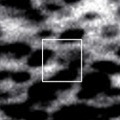
|
Now it is 18.2 mag (June 6, iTelescope Observatory, Mayhill). It will keep 16-17 mag for a long time from 2014 summer to early 2016.
Date(TT) R.A. (2000) Decl. Delta r Elong. m1 Best Time(A, h)
July 5 16 48.44 -25 50.0 1.900 2.833 151 17.2 21:55 ( 0, 29)
July 12 16 44.28 -25 25.9 1.921 2.803 143 17.1 21:23 ( 0, 30)
|
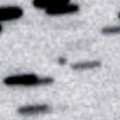
|
Now it is 16.4 mag (May 7, Taras Prystavski). It keeps 17-18 mag for a long time from 2014 to 2016.
Date(TT) R.A. (2000) Decl. Delta r Elong. m1 Best Time(A, h)
July 5 13 19.29 -10 35.6 5.268 5.528 99 17.2 21:03 ( 47, 31)
July 12 13 15.76 -10 38.6 5.383 5.515 92 17.3 20:59 ( 52, 27)
|

|
Now it is 17.8 mag (Apr. 26, A. Maury, J.-F. Soulier). It has brightened in outburst up to 14 mag twice, in 2006 January and 2011 May. It will pass the perihelion in 2015. It keeps observable at 17 mag for a long time after this.
Date(TT) R.A. (2000) Decl. Delta r Elong. m1 Best Time(A, h)
July 5 21 16.39 -12 20.3 5.122 5.982 144 17.4 2:26 ( 0, 43)
July 12 21 14.54 -12 28.8 5.058 5.975 151 17.3 1:57 ( 0, 43)
|

|
Now it is 17.0 mag (June 10, Catalina Sky Survey). It is observable at 17-18 mag from July to August.
Date(TT) R.A. (2000) Decl. Delta r Elong. m1 Best Time(A, h)
July 5 21 6.67 -17 1.6 0.909 1.854 148 17.5 2:16 ( 0, 38)
July 12 21 9.58 -17 41.5 0.887 1.858 154 17.4 1:52 ( 0, 37)
|

|
First return of a new periodic comet discovered in 2005. It was expected to be observable at 17 mag for a long time from 2013 to 2014. However, it has not been recovered yet. Actually, it is much fainter than predicted, fainter than 20 mag (2013 Aug. 6, Jean-Francois Soulier).
Date(TT) R.A. (2000) Decl. Delta r Elong. m1 Best Time(A, h)
July 5 23 9.24 -7 27.2 2.711 3.303 117 17.5 3:05 (334, 44)
July 12 23 10.08 -7 38.9 2.636 3.311 123 17.5 3:11 (345, 46)
|

|
Now it is 18.9 mag (June 17, Hidetaka Sato). It will brighten very rapidly after this. It is expected to be observable at 14.5 mag in excellent condition from October to December.
Date(TT) R.A. (2000) Decl. Delta r Elong. m1 Best Time(A, h)
July 5 2 6.75 1 49.7 2.023 1.978 72 17.9 3:05 (285, 23)
July 12 2 21.03 3 12.3 1.933 1.947 75 17.7 3:11 (287, 28)
|

|
Now it is 19.4 mag (June 2, Erwin Schwab and Pablo Ruiz). It keeps observable at 17-18 mag in good condition from July to October.
Date(TT) R.A. (2000) Decl. Delta r Elong. m1 Best Time(A, h)
July 5 22 26.08 -15 37.8 1.834 2.606 129 18.0 3:05 (351, 39)
July 12 22 26.96 -15 26.1 1.759 2.591 136 17.9 3:09 ( 0, 40)
|
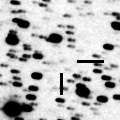
|
Now it is 18.4 mag (June 7, J. Nicolas, A. Klotz, F. Kugel, C. Rinner). It is observable at 18 mag in good condition from spring to summer.
Date(TT) R.A. (2000) Decl. Delta r Elong. m1 Best Time(A, h)
July 5 21 13.45 14 16.9 1.322 2.122 129 17.9 2:23 ( 0, 69)
July 12 21 8.28 15 57.4 1.315 2.151 134 17.9 1:51 ( 0, 71)
|

|
It brightened up to 12-13 mag from 2012 to 2013. It has already gone away. But it is bright as 16.8 mag still now (May 29, K. Hills). It keeps 17-18 mag for a while, and it will be observable in good condition in the Southern Hemisphere. It will be getting higher gradually also in the Northern Hemisphere.
Date(TT) R.A. (2000) Decl. Delta r Elong. m1 Best Time(A, h)
July 5 0 54.84 -12 35.5 3.599 3.824 94 17.9 3:05 (310, 26)
July 12 0 57.80 -12 46.6 3.520 3.841 100 17.9 3:11 (317, 31)
|
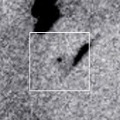
|
Now it is 19.4 mag (May 3, A. Waszczak). First return of a new periodic comet which brightened up to 13 mag in outburst in 2008. It will be observable in good condition from spring to summer. However, it will be only 19-20 mag at best in this apparition.
Date(TT) R.A. (2000) Decl. Delta r Elong. m1 Best Time(A, h)
July 5 12 41.98 6 16.2 2.243 2.373 84 19.9 21:03 ( 69, 37)
July 12 12 49.92 4 51.8 2.315 2.367 80 19.9 20:59 ( 70, 33)
|
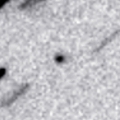
|
It was observed at 17.5 mag in early 2013. It was predicted to be observable at 17.5 mag again from spring to summer in 2014. But actually, it is 20.6 mag (June 21, Hidetaka Sato), much fainter than predicted by 3 mag.
Date(TT) R.A. (2000) Decl. Delta r Elong. m1 Best Time(A, h)
July 5 19 28.53 -14 45.9 1.968 2.972 168 20.7 0:39 ( 0, 40)
July 12 19 23.80 -15 21.8 1.981 2.993 173 20.8 0:07 ( 0, 40)
|
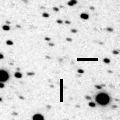
|
It was discovered in 1819, and re-discovered in 2003. Although it was predicted to be extremely faint as 26 mag, it unusually brightened up to 17.5 mag in outburst in 2013 July (July 6, Hidetaka Sato). However, no observations have been reported since mid July. It will pass the perihelion in 2014 August, and will approach to the sun down to 0.96 a.u. The brightness is predicted to be 23 mag at best. However, if the cometary activity continues, it may be observed brighter. Yasukazu Ikari reported it was not detected, fainter than 15.5 mag, on May 23.
Date(TT) R.A. (2000) Decl. Delta r Elong. m1 Best Time(A, h)
July 5 3 33.98 15 39.1 1.648 1.225 47 22.5 3:05 (260, 13)
July 12 4 4.48 17 37.4 1.598 1.170 46 22.5 3:11 (259, 15)
|
|
![]()
 117P/Helin-Roman-Alu 1
117P/Helin-Roman-Alu 1 29P/Schwassmann-Wachmann 1
29P/Schwassmann-Wachmann 1 C/2010 S1 ( LINEAR )
C/2010 S1 ( LINEAR ) 17P/Holmes
17P/Holmes C/2013 Y2 ( PanSTARRS )
C/2013 Y2 ( PanSTARRS ) 32P/Comas Sola
32P/Comas Sola 134P/Kowal-Vavrova
134P/Kowal-Vavrova C/2006 S3 ( LONEOS )
C/2006 S3 ( LONEOS ) C/2011 J2 ( LINEAR )
C/2011 J2 ( LINEAR ) C/2013 V1 ( Boattini )
C/2013 V1 ( Boattini ) C/2012 F3 ( PanSTARRS )
C/2012 F3 ( PanSTARRS ) P/2014 L2 ( NEOWISE )
P/2014 L2 ( NEOWISE ) (596) Scheila
(596) Scheila 106P/Schuster
106P/Schuster 16P/Brooks 2
16P/Brooks 2 290P/2013 N1 ( Jager )
290P/2013 N1 ( Jager ) 72P/Denning-Fujikawa
72P/Denning-Fujikawa C/2013 US10 ( Catalina )
C/2013 US10 ( Catalina ) 222P/LINEAR
222P/LINEAR 209P/LINEAR
209P/LINEAR P/2012 B1 ( PanSTARRS )
P/2012 B1 ( PanSTARRS ) C/2011 KP36 ( Spacewatch )
C/2011 KP36 ( Spacewatch ) 284P/2013 J1 ( McNaught )
284P/2013 J1 ( McNaught ) 300P/2014 G2 ( Catalina )
300P/2014 G2 ( Catalina ) C/2014 A4 ( SONEAR )
C/2014 A4 ( SONEAR ) C/2013 G3 ( PanSTARRS )
C/2013 G3 ( PanSTARRS ) C/2009 F4 ( McNaught )
C/2009 F4 ( McNaught ) P/2014 E1 ( Larson )
P/2014 E1 ( Larson ) C/2012 K8 ( Lemmon )
C/2012 K8 ( Lemmon ) 181P/Shoemaker-Levy 6
181P/Shoemaker-Levy 6 44P/Reinmuth 2
44P/Reinmuth 2 C/2013 G9 ( Tenagra )
C/2013 G9 ( Tenagra ) 174P/(60558) 2000 EC98 ( Echeclus )
174P/(60558) 2000 EC98 ( Echeclus ) P/2014 L3 ( Hill )
P/2014 L3 ( Hill ) P/2005 L1 ( McNaught )
P/2005 L1 ( McNaught ) 108P/Ciffreo
108P/Ciffreo 303P/2014 L1 ( NEAT )
303P/2014 L1 ( NEAT ) 296P/2014 A1 ( Garradd )
296P/2014 A1 ( Garradd ) 246P/2010 V2 ( NEAT )
246P/2010 V2 ( NEAT ) 297P/2014 D1 ( Beshore )
297P/2014 D1 ( Beshore ) 280P/2013 C1 ( Larsen )
280P/2013 C1 ( Larsen ) 289P/Blanpain
289P/Blanpain![]()









































